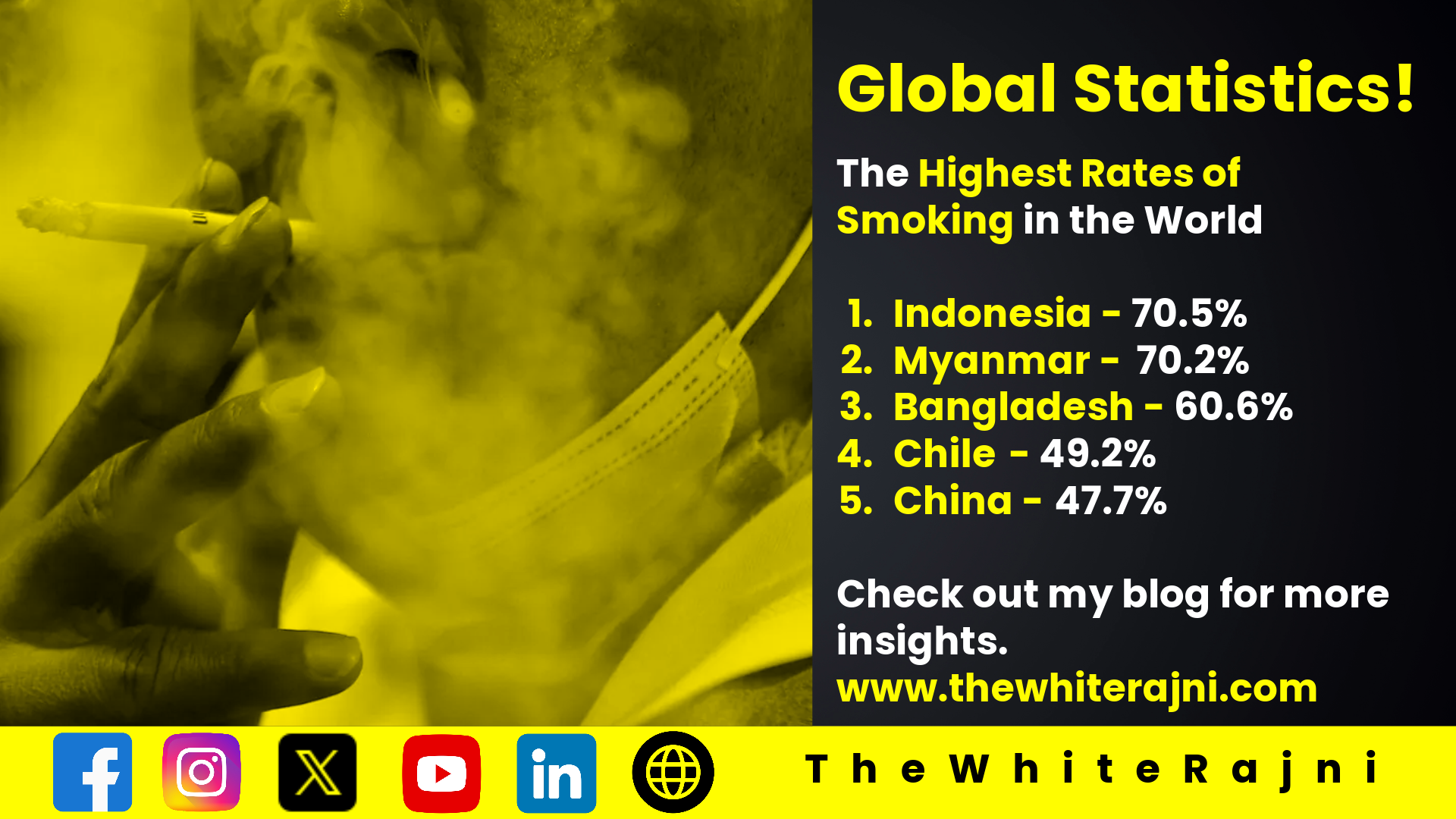Smoking remains one of the most significant public health challenges globally. It’s a major risk factor for several chronic diseases, including cancer, heart disease, and stroke, and is a leading cause of preventable deaths worldwide. The prevalence of smoking, however, varies dramatically from one country to another. Generally, countries with higher rates of smoking often exhibit lower levels of economic development and education. In this article, we’ll delve into the countries with the highest rates of smoking among men in 2023:
| Rank | Flag | Country | Rate of Smoking (% of Men) |
|---|---|---|---|
| 1 | 🇮🇩 | Indonesia | 70.5% |
| 2 | 🇲🇲 | Myanmar | 70.2% |
| 3 | 🇧🇩 | Bangladesh | 60.6% |
| 4 | 🇨🇱 | Chile | 49.2% |
| 5 | 🇨🇳 | China | 47.7% |
| 6 | 🇿🇦 | South Africa | 46.8% |
| 7 | 🇬🇷 | Greece | 45.3% |
| 8 | 🇱🇰 | Sri Lanka | 43.2% |
| 9 | 🇲🇾 | Malaysia | 42.7% |
| 10 | 🇹🇭 | Thailand | 42.5% |
| 11 | 🇪🇬 | Egypt | 42.3% |
| 12 | 🇰🇿 | Kazakhstan | 42.2% |
| 13 | 🇮🇳 | India | 42% |
| 14 | 🇵🇭 | Philippines | 41.6% |
| 15 | 🇹🇷 | Turkey | 41.5% |
| 16 | 🇺🇦 | Ukraine | 41% |
| 17 | 🇷🇺 | Russia | 40.9% |
| 18 | 🇮🇶 | Iraq | 40.8% |
| 19 | 🇷🇸 | Serbia | 40% |
| 20 | 🇰🇷 | South Korea | 38.2% |
| 21 | 🇭🇷 | Croatia | 37.9% |
| 22 | 🇰🇵 | North Korea | 37.5% |
| 23 | 🇰🇭 | Cambodia | 37.4% |
| 24 | 🇩🇿 | Algeria | 36.3% |
| 25 | 🇫🇷 | France | 36% |
| 26 | 🇦🇪 | United Arab Emirates | 35.6% |
| 27 | 🇷🇴 | Romania | 35.2% |
| 28 | 🇮🇱 | Israel | 35.2% |
| 29 | 🇭🇺 | Hungary | 34.8% |
| 30 | 🇵🇰 | Pakistan | 33.6% |
| 31 | 🇵🇹 | Portugal | 33.3% |
| 32 | 🇯🇵 | Japan | 33.2% |
| 33 | 🇸🇦 | Saudi Arabia | 31.2% |
| 34 | 🇺🇸 | United States | 30.9% |
| 35 | 🇦🇹 | Austria | 30.4% |
| 36 | 🇵🇱 | Poland | 30.3% |
| 37 | 🇩🇪 | Germany | 29.9% |
| 38 | 🇪🇸 | Spain | 29.1% |
| 39 | 🇦🇷 | Argentina | 28.2% |
| 40 | 🇨🇭 | Switzerland | 27.8% |
| 41 | 🇸🇬 | Singapore | 27.8% |
| 42 | 🇮🇹 | Italy | 27.1% |
| 43 | 🇧🇪 | Belgium | 26.9% |
| 44 | 🇮🇪 | Ireland | 26.1% |
| 45 | 🇳🇱 | Netherlands | 25.6% |
| 46 | 🇮🇷 | Iran | 24.6% |
| 47 | 🇨🇦 | Canada | 22.7% |
| 48 | 🇧🇷 | Brazil | 21.5% |
| 49 | 🇲🇽 | Mexico | 21.2% |
| 50 | 🇬🇧 | United Kingdom | 21.1% |
| 51 | 🇫🇮 | Finland | 21% |
| 52 | 🇦🇺 | Australia | 18.7% |
| 53 | 🇩🇰 | Denmark | 18.4% |
| 54 | 🇳🇴 | Norway | 15.5% |
| 55 | 🇳🇬 | Nigeria | 9% |
| 56 | 🇪🇹 | Ethiopia | 8.3% |
| 57 | 🇸🇪 | Sweden | 6% |
The table above illustrates the diverse rates of smoking across the globe, with Indonesia and Myanmar having the highest rates among men, exceeding 70%. These rates are influenced by various factors, including cultural perceptions, peer pressure, advertising, and the accessibility of tobacco products.
High rates of smoking can lead to several adverse consequences for a country:
- Increased Health Care Costs: Smoking-related illnesses can result in substantial healthcare expenses.
- Reduced Productivity: Smokers are more likely to miss work due to illness, impacting productivity.
- Increased Fire Risk: Smoking is a major cause of fires, posing a threat to property and lives.
- Environmental Damage: Tobacco production contributes to deforestation and air pollution.
Addressing high rates of smoking requires a multifaceted approach:
- Education: Governments can raise awareness about the dangers of smoking and provide information on how to quit.
- Regulation: Governments can regulate the tobacco industry, including banning tobacco advertising and raising taxes on tobacco products.
- Support Services: Providing support services to help people quit smoking, such as counseling and nicotine replacement therapy.
Addressing high rates of smoking is a complex but crucial endeavor. By taking these steps, countries can improve public health and well-being, reduce healthcare costs, and mitigate the negative social and environmental impacts of smoking.










